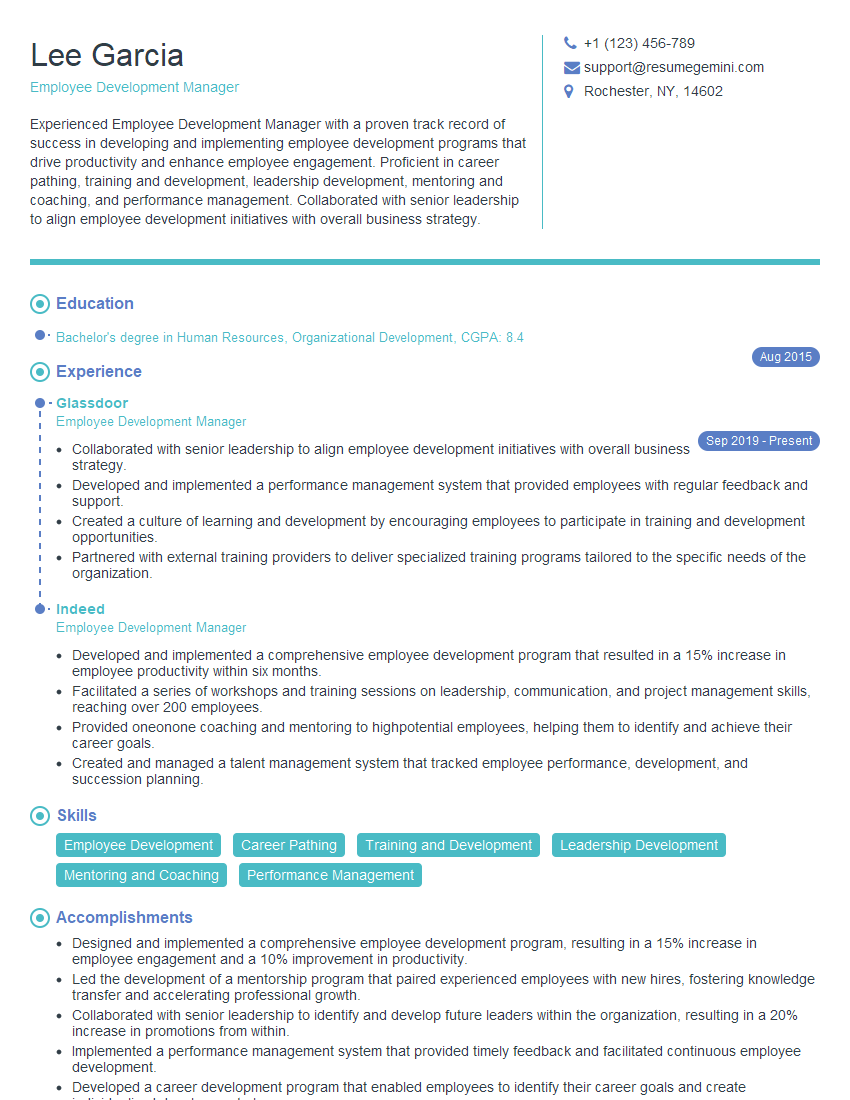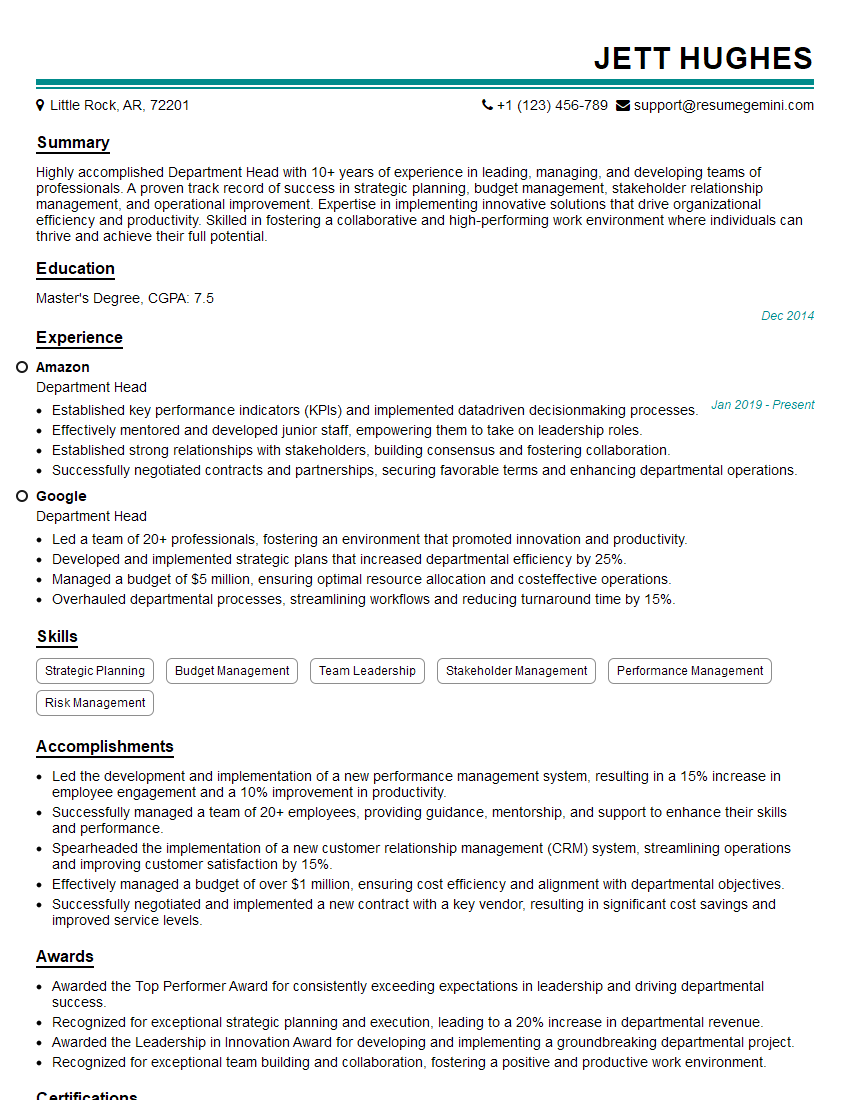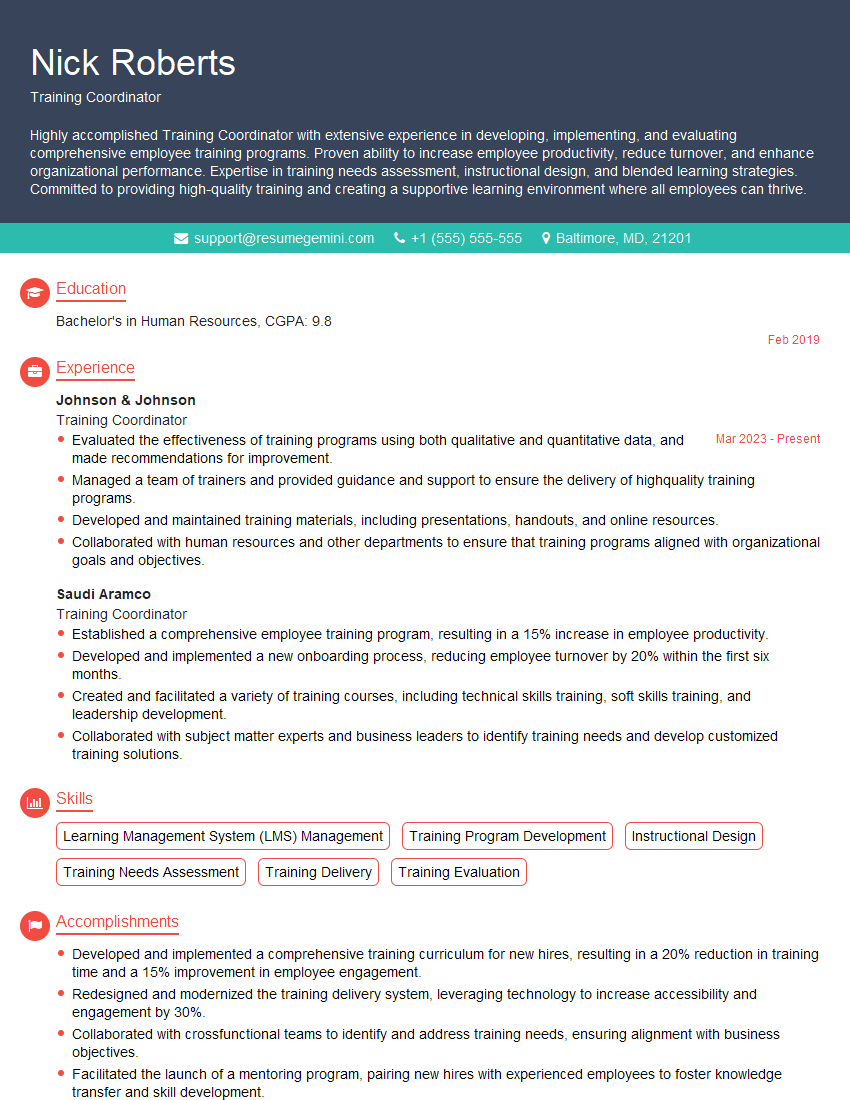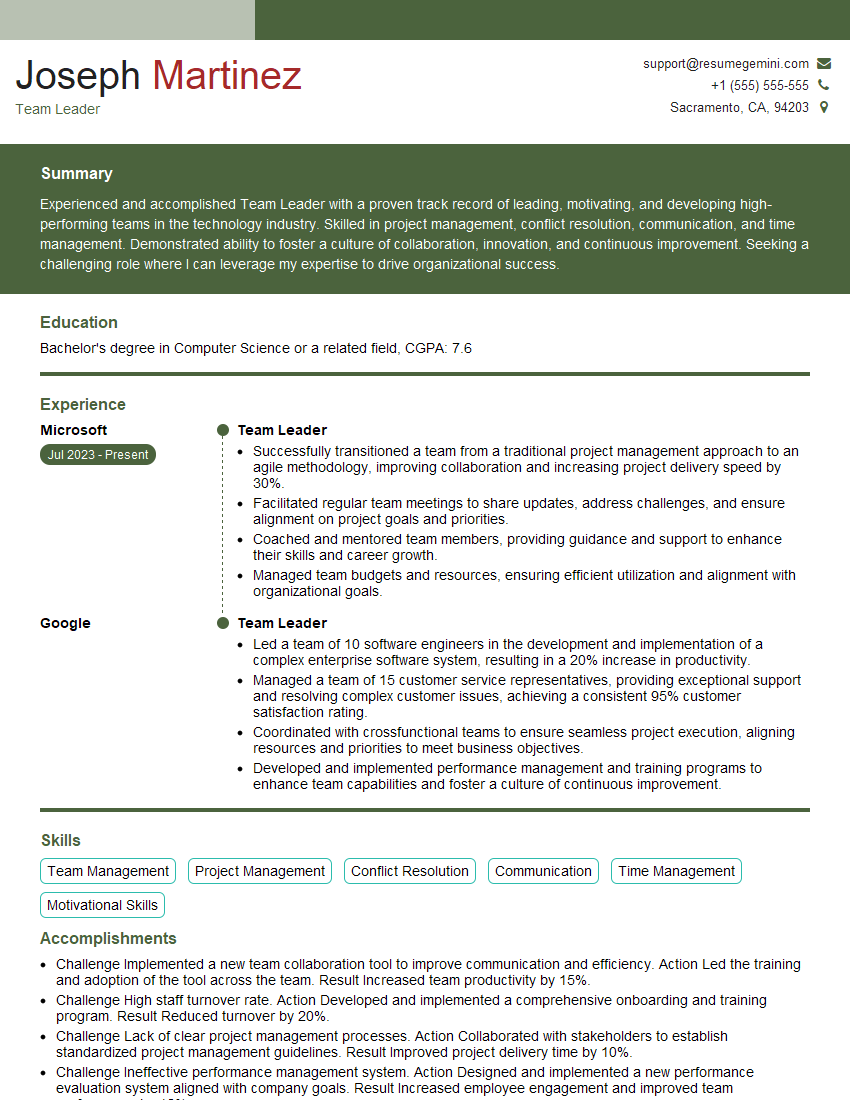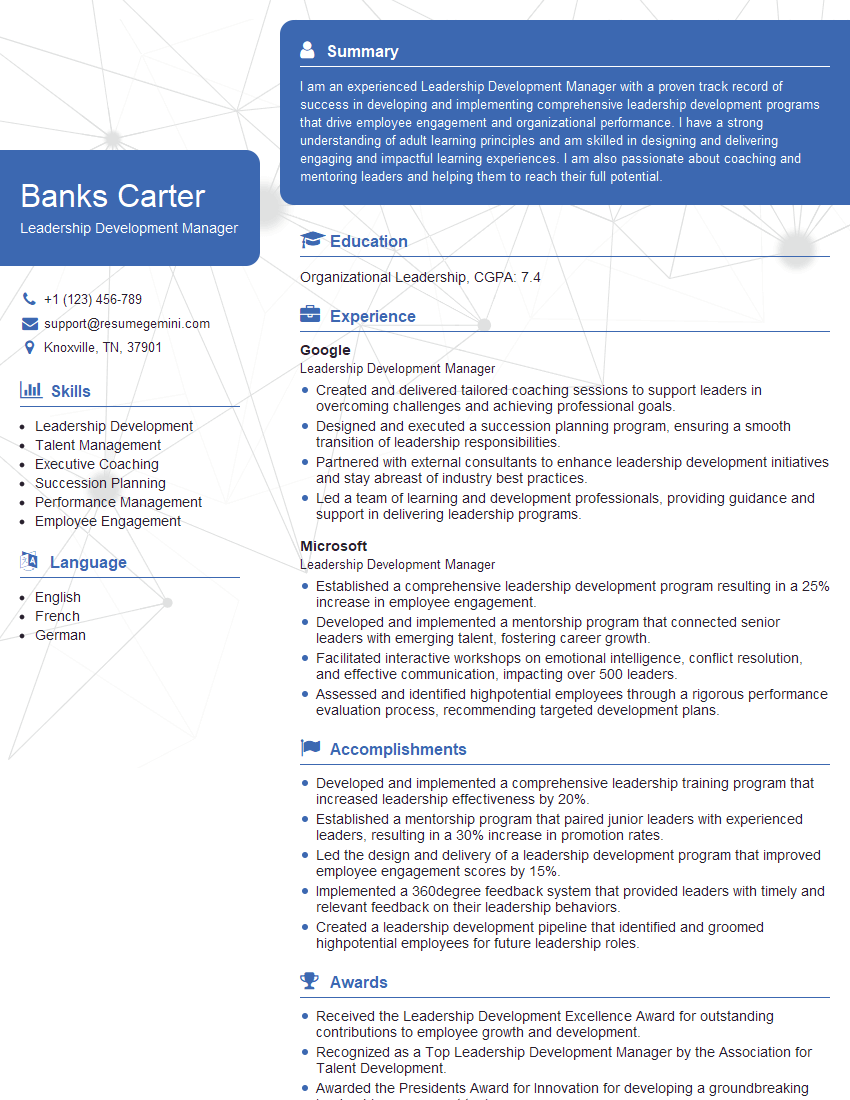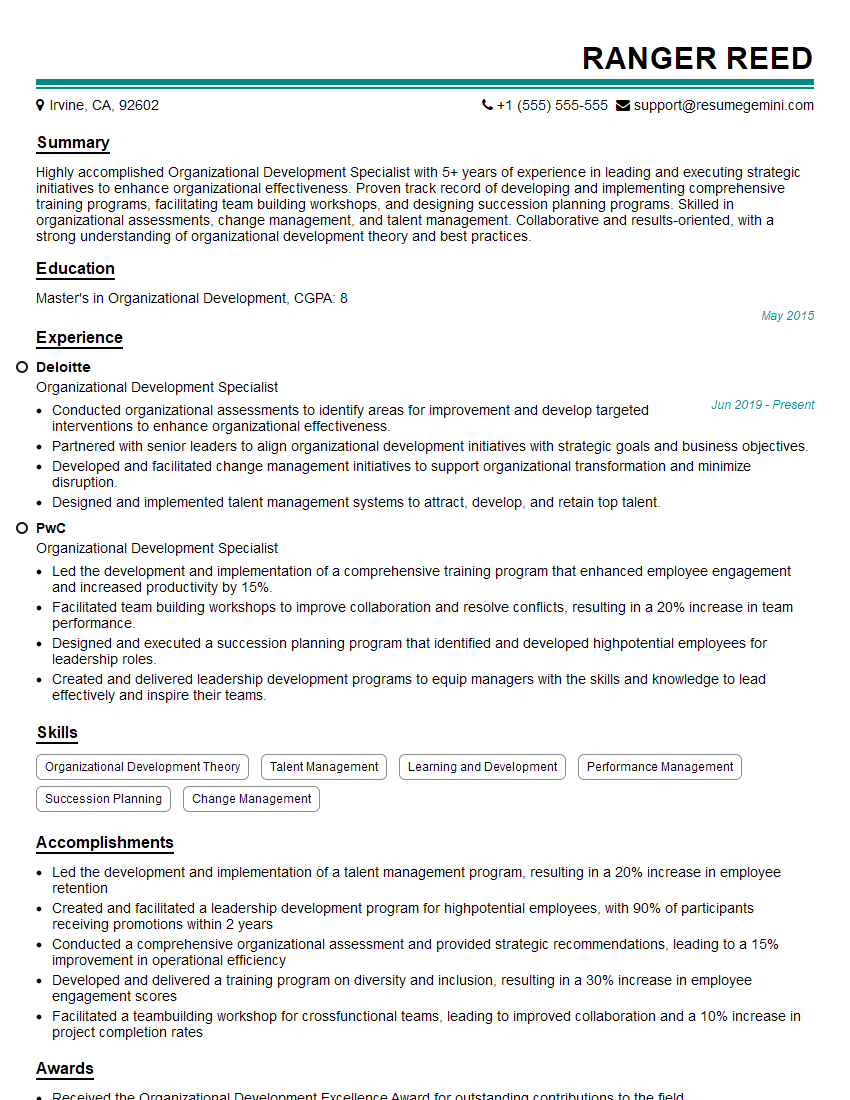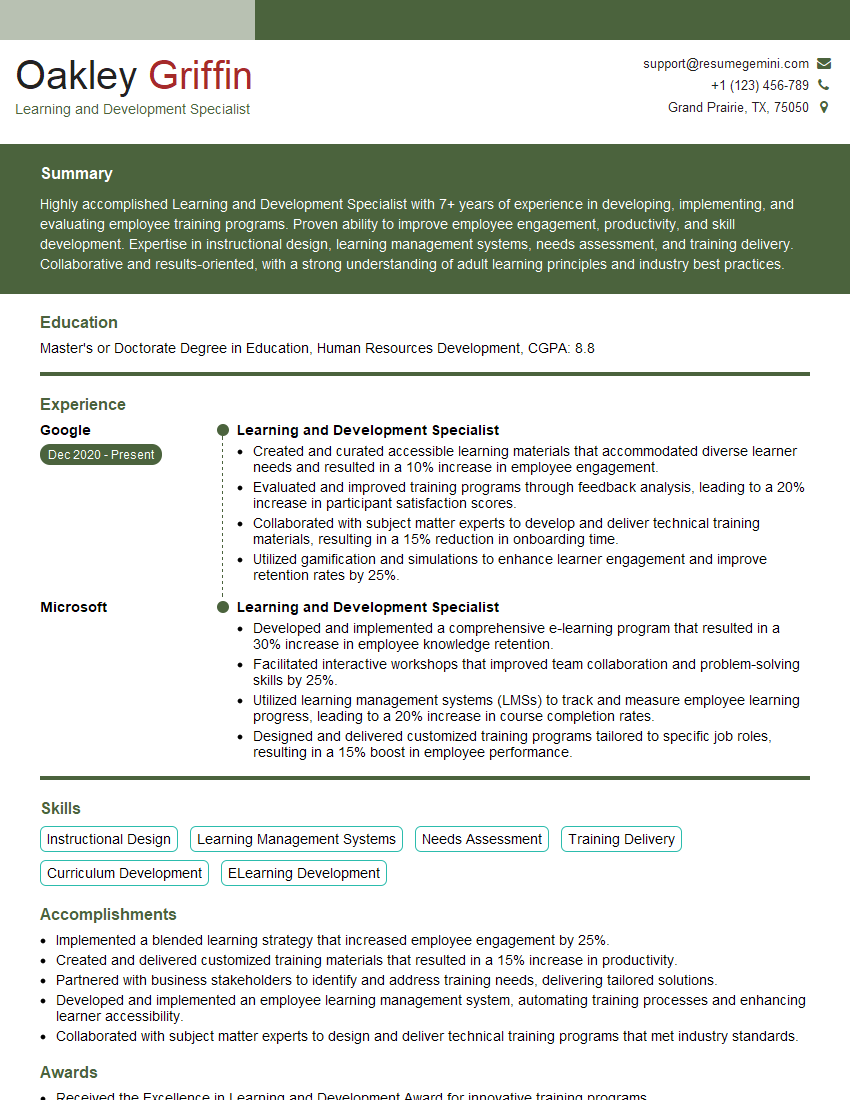The thought of an interview can be nerve-wracking, but the right preparation can make all the difference. Explore this comprehensive guide to Supervision and Training of Staff interview questions and gain the confidence you need to showcase your abilities and secure the role.
Questions Asked in Supervision and Training of Staff Interview
Q 1. Describe your experience designing and delivering training programs.
Designing and delivering effective training programs requires a systematic approach. It begins with a thorough needs analysis to identify skill gaps and learning objectives. I then develop a curriculum that incorporates diverse learning methods – lectures, hands-on activities, group discussions, role-playing, and simulations – to cater to different learning styles. For example, when training staff on a new customer relationship management (CRM) system, I wouldn’t just give a lecture; I’d incorporate practical exercises where they input sample data, navigate the system, and troubleshoot common issues. Finally, I always ensure that the training is aligned with the organization’s overall goals and that participants receive clear, measurable learning outcomes. Post-training assessments and follow-up sessions solidify knowledge retention and application.
In one instance, I designed a training program for a team struggling with conflict resolution. The program included workshops on communication styles, active listening techniques, and conflict management strategies, culminating in a role-playing exercise where participants practiced handling difficult conversations. This resulted in a noticeable improvement in team dynamics and productivity.
Q 2. How do you assess the effectiveness of your training programs?
Assessing training effectiveness is crucial to ensure return on investment and continuous improvement. I employ a multi-faceted approach that includes pre- and post-training assessments to measure knowledge gain, observation of on-the-job performance, and gathering feedback through surveys and interviews. Pre-training assessments help gauge existing knowledge levels, establishing a baseline for comparison. Post-training assessments, ideally incorporating practical application scenarios, directly measure knowledge retention and skill development. For example, a pre-training quiz on safety procedures followed by an on-the-job observation checklist after the training, reveals the true impact of the program. Regular follow-up sessions and informal check-ins allow me to track long-term skill retention and address any ongoing challenges.
Analyzing the data gathered from these different methods allows me to identify areas where the training needs improvement and refine the curriculum for future delivery. A low score on a post-training assessment might signal a need for more engaging activities or a different instructional approach for specific concepts.
Q 3. What methods do you use to identify training needs within a team?
Identifying training needs involves a combination of methods designed to collect information from multiple sources. I start by reviewing performance data, such as sales figures, customer satisfaction scores, and error rates. This helps to pinpoint areas where improvement is needed. I then conduct interviews and focus groups with team members and managers to gather their perspectives on current skills and required training. Observations of employees at work, alongside analysis of performance reviews, also play a key role. Finally, I utilize surveys and questionnaires to collect broader input and identify any emerging training needs within the team.
For instance, if sales figures are consistently below target and feedback suggests a lack of knowledge about a new product line, a targeted training program focused on product knowledge and sales techniques would be developed. This multi-pronged approach ensures a comprehensive understanding of training needs, leading to more effective and impactful interventions.
Q 4. Explain your approach to providing constructive feedback to staff.
Providing constructive feedback is a critical skill for effective supervision. My approach centers around the concept of ‘sandwich feedback,’ where positive feedback is given before and after any constructive criticism. This helps create a receptive environment and prevents defensiveness. The feedback is specific, focusing on observable behaviors rather than personality traits. For example, instead of saying ‘You’re lazy,’ I’d say, ‘I’ve noticed your reports are often submitted late; can we discuss strategies to improve your time management?’ I also focus on solutions, offering suggestions or resources to help the employee improve. The feedback session concludes with a plan for improvement and follow-up steps, ensuring the employee understands expectations and feels supported.
It’s crucial to create a safe space for open communication where the employee feels comfortable receiving and acting on feedback. Regular feedback, rather than infrequent, large-scale critiques, promotes continuous improvement and prevents issues from accumulating.
Q 5. How do you handle conflict resolution within a team?
Conflict resolution requires a structured and impartial approach. I start by actively listening to all parties involved, ensuring each person feels heard and understood. I then work to identify the root cause of the conflict, moving beyond surface-level disagreements to address underlying issues. I facilitate a collaborative discussion, helping individuals find common ground and develop solutions that meet everyone’s needs. Where necessary, I might mediate, guiding the discussion and suggesting compromise strategies. It’s important to focus on the issue at hand, not on personalities or assigning blame. The goal is to find a resolution that fosters improved communication and collaboration within the team.
For example, if two team members are constantly clashing over project responsibilities, I would facilitate a meeting to clarify roles and expectations, perhaps even adjusting responsibilities to better align with each individual’s skills and preferences. The focus is on finding a solution that works for the team, not just on appeasing one party or the other.
Q 6. Describe your experience with performance management systems.
My experience with performance management systems spans various methodologies, from traditional annual reviews to more contemporary approaches focused on continuous feedback and development. I’m proficient in utilizing systems that track key performance indicators (KPIs), set clear goals and expectations, and provide regular feedback mechanisms. I believe in aligning performance goals with organizational objectives, ensuring that individual contributions directly contribute to overall success. Furthermore, I utilize systems that allow for objective and transparent performance evaluations, minimizing biases and ensuring fairness. This could involve using standardized rating scales, 360-degree feedback, and documented performance examples.
I’ve successfully implemented performance management systems that have resulted in increased employee engagement and improved overall team performance. A key element is ensuring the system is not just a tool for evaluation, but also a platform for growth and development, providing opportunities for employees to identify their strengths and weaknesses, and to set goals for future development.
Q 7. How do you motivate and engage team members in their professional development?
Motivating and engaging team members in their professional development requires a personalized approach that recognizes individual needs and aspirations. I start by understanding each team member’s career goals and ambitions, creating individualized development plans that align with their aspirations and the organization’s needs. This involves providing opportunities for skill development through training courses, mentoring programs, job shadowing, and cross-functional projects. I also encourage participation in conferences and workshops, and support employees in pursuing certifications or advanced degrees relevant to their career paths.
Recognition and appreciation are vital. I regularly acknowledge and celebrate achievements, both big and small, fostering a positive and supportive work environment where employees feel valued and motivated to grow. Regular check-ins provide opportunities to discuss progress, address challenges, and offer guidance and support. Creating a culture of continuous learning and development, where improvement is seen as an ongoing process, is key to fostering a highly engaged and motivated team.
Q 8. What strategies do you use to ensure consistent performance within a team?
Ensuring consistent high performance within a team requires a multifaceted approach focusing on clear expectations, ongoing feedback, and continuous improvement. It’s not just about achieving individual targets, but fostering a collaborative environment where everyone understands their role and contributes effectively.
- Clear Roles and Responsibilities: I begin by ensuring each team member has a clear understanding of their job description, key performance indicators (KPIs), and how their work contributes to the overall team goals. This often involves a documented job description and regular one-on-one meetings to clarify expectations.
- Regular Feedback and Coaching: I implement a system of regular feedback, both positive reinforcement and constructive criticism, delivered through formal performance reviews and informal check-ins. I focus on providing specific examples rather than generalizations, and I always aim to provide actionable steps for improvement.
- Training and Development: Consistent performance depends on adequate training and development opportunities. I identify skill gaps and provide access to relevant training programs, workshops, or mentoring opportunities to enhance capabilities. I also encourage peer-to-peer learning and knowledge sharing within the team.
- Performance Monitoring and Analysis: I use data-driven approaches to track team performance against KPIs, identifying trends and areas needing attention. This helps me proactively address potential issues before they escalate into bigger problems. Regular team meetings also provide an opportunity to address challenges collaboratively.
- Recognition and Rewards: Finally, I believe in acknowledging and rewarding good performance. Recognizing achievements, both big and small, helps to motivate the team and reinforces positive behaviors.
For example, in my previous role, we implemented a monthly ‘Team Spotlight’ where we highlighted individual and team successes. This simple initiative significantly boosted morale and improved overall performance.
Q 9. How do you delegate tasks effectively and provide support to your team?
Effective delegation is about assigning tasks to the right people, empowering them to succeed, and providing ongoing support. It’s a crucial skill for any supervisor, allowing you to focus on strategic initiatives while developing your team.
- Assess Team Member Skills: I begin by evaluating each team member’s skills, experience, and capacity. I consider their strengths and areas for growth when assigning tasks. This ensures that tasks are aligned with individual capabilities, maximizing efficiency and fostering a sense of ownership.
- Provide Clear Instructions and Expectations: When delegating, I ensure the task is clearly defined, including specific objectives, deadlines, and expected outcomes. I also clarify any constraints or potential challenges and encourage questions to ensure complete understanding.
- Empowerment and Autonomy: I provide team members with the autonomy to decide how to best approach the task, fostering their problem-solving skills and building confidence. I avoid micromanagement and trust them to manage their workload effectively.
- Provide Regular Support and Feedback: I offer regular check-ins to provide support, answer questions, and monitor progress. This ensures tasks stay on track and addresses any roadblocks promptly. I also give constructive feedback on their performance to help them improve their skills and approach.
- Recognition and Appreciation: Acknowledging their contribution and efforts upon task completion helps to build confidence and motivation, reinforcing the value of delegation for both the team and individual.
For instance, I once delegated a complex project to a junior member who initially expressed some apprehension. By providing regular support and guidance, I enabled them to successfully complete the project, significantly boosting their confidence and skillset.
Q 10. Explain your process for onboarding new team members.
Onboarding new team members is a critical process to ensure a smooth transition and rapid integration. It’s an investment that yields significant returns in terms of team productivity and employee retention.
- Pre-boarding: Before the first day, I send a welcome package with essential information, including details about the team, company culture, and upcoming training schedules. This helps alleviate anxiety and creates a positive first impression.
- Orientation: The first day includes an introduction to the company, team members, and workspace. I provide an overview of their role, responsibilities, and immediate priorities. This sets the stage for a productive and focused start.
- Structured Training: I provide structured training on relevant systems, processes, and tools. This training aligns with the individual’s role and learning style. I might use a combination of online modules, shadowing, and hands-on training.
- Mentorship and Buddy System: Assigning a mentor or buddy can help the new employee navigate the company culture and build relationships. This provides ongoing support and guidance, addressing questions and concerns.
- Regular Check-ins and Feedback: I schedule regular check-ins during the initial weeks and months to monitor progress, provide feedback, and address any challenges. This ensures they are comfortable and productive in their role.
- 30/60/90 Day Review: A formal 30/60/90-day review provides an opportunity to assess progress, discuss goals, and identify areas for development. This process helps create a collaborative growth plan.
I find a structured onboarding program significantly reduces the time it takes a new team member to become fully productive and integrated into the team.
Q 11. Describe a time you had to address a performance issue within your team.
Addressing performance issues requires a sensitive and structured approach. It’s crucial to be fair, consistent, and focus on improvement rather than punishment.
In one instance, a team member consistently missed deadlines and lacked attention to detail. I initially addressed this informally, providing constructive feedback and offering support. However, when the issues persisted, I followed a formal performance improvement plan (PIP). This involved:
- Documentation: Thorough documentation of the performance issues, including specific examples and dates.
- Meeting: A private meeting to discuss the performance issues, focusing on specific behaviors and their impact. I listened actively to their perspective and explored potential reasons for the underperformance.
- Performance Improvement Plan (PIP): We collaboratively developed a PIP outlining specific goals, timelines, and support mechanisms. This plan included regular check-ins to monitor progress and provide ongoing feedback.
- Training and Support: We identified training needs and provided access to resources to help improve skills and address knowledge gaps.
- Follow-up and Evaluation: Regular follow-up meetings were scheduled to assess progress against the PIP. This ensured accountability and provided opportunities for adjustment.
While the situation was challenging, following a structured process and demonstrating empathy helped the team member improve their performance and retain their position. The key was to focus on rehabilitation and support rather than immediate dismissal.
Q 12. How do you adapt your training style to suit different learning styles?
Recognizing that individuals learn differently is crucial for effective training. Adapting my style ensures everyone receives the information they need in a way that works best for them. I use a variety of methods to accommodate different learning styles:
- Visual Learners: For visual learners, I use diagrams, charts, presentations, and videos. I minimize lengthy text-based explanations and utilize visual aids to convey complex information.
- Auditory Learners: I leverage discussions, lectures, and audio recordings for auditory learners. I incorporate group discussions and presentations to engage them.
- Kinesthetic Learners: Hands-on activities, simulations, role-playing, and real-world applications cater to kinesthetic learners. This active learning approach helps solidify concepts and build practical skills.
- Mixed-Mode Approach: Often, I adopt a mixed-mode approach, integrating various methods to cater to the diverse learning preferences within a team. This ensures everyone has multiple opportunities to grasp the material.
- Individualized Learning Plans: In some cases, particularly when working with larger teams or individuals with specific learning needs, I develop individualized learning plans to tailor training to their specific requirements.
For example, when training a team on a new software program, I’d provide online tutorials for visual learners, conduct interactive workshops for kinesthetic learners, and provide audio guides for auditory learners.
Q 13. What are some common challenges you face in supervision and training, and how do you address them?
Supervision and training present several common challenges. However, proactive planning and effective strategies can mitigate these obstacles.
- Resistance to Change: Some team members may resist new training or changes in procedures. Addressing this requires clear communication, demonstrating the benefits of the changes, and actively addressing concerns. Involving the team in the change process can also increase buy-in.
- Time Constraints: Balancing training with daily operational tasks can be challenging. Effective time management, prioritization, and leveraging technology (e.g., online training modules) can help address this issue.
- Lack of Resources: Limited budgets or access to training materials can be a significant barrier. Exploring cost-effective solutions, such as online resources or internal training programs, can help overcome this challenge.
- Measuring Effectiveness: Demonstrating the ROI of training initiatives can be difficult. Clear objectives, pre- and post-training assessments, and tracking key performance indicators (KPIs) can help measure the success of training programs.
- Maintaining Motivation and Engagement: Keeping trainees motivated and engaged throughout the training process is essential. Varying teaching methods, providing regular feedback, and making the learning relevant and applicable to their roles helps enhance engagement.
For instance, to address time constraints, I often break down training into shorter, more manageable modules delivered throughout the week rather than conducting lengthy sessions.
Q 14. How do you measure the return on investment (ROI) of training initiatives?
Measuring the return on investment (ROI) of training initiatives is essential to justify their cost and demonstrate their value. It’s not just about tracking immediate results, but also considering long-term impacts on productivity and employee retention.
- Define Clear Objectives: Before starting any training program, clearly define specific, measurable, achievable, relevant, and time-bound (SMART) objectives. This provides a benchmark against which to measure success.
- Pre- and Post-Training Assessments: Conduct pre- and post-training assessments to measure the improvement in knowledge, skills, and attitudes. This helps quantify the impact of training on employee capabilities.
- Track Key Performance Indicators (KPIs): Identify relevant KPIs that align with the training objectives. This could include metrics like improved productivity, reduced error rates, increased sales, or enhanced customer satisfaction.
- Cost-Benefit Analysis: Calculate the total cost of the training program, including materials, instructor fees, and employee time. Then, compare these costs to the benefits achieved, such as increased productivity or reduced errors.
- Long-Term Impact: Assess the long-term impact of the training, such as reduced employee turnover, improved employee morale, and enhanced organizational capabilities. These intangible benefits contribute significantly to the overall ROI.
For example, if a training program aimed at improving sales techniques resulted in a 10% increase in sales, and the cost of the training was $5,000, the ROI would be significantly positive. It’s vital to quantify these improvements to showcase the effectiveness and justify future investment in training initiatives.
Q 15. What technologies or tools do you use to support supervision and training?
To support supervision and training, I leverage a variety of technologies and tools, tailored to the specific needs of the team and training objective. This includes Learning Management Systems (LMS) like Moodle or Canvas for delivering online courses, tracking progress, and managing assessments. For real-time collaboration and feedback, I utilize video conferencing platforms like Zoom or Microsoft Teams. These facilitate virtual training sessions, one-on-one coaching, and group discussions. Performance management software helps monitor individual progress and identify areas needing further attention. Finally, I also utilize document management systems for easy access to training materials, policies, and procedures. For example, during a recent project, we used a combination of Canvas for delivering the initial theoretical modules, Zoom for interactive workshops and Q&A sessions, and a dedicated project management tool for tracking individual task completions and providing tailored feedback.
Career Expert Tips:
- Ace those interviews! Prepare effectively by reviewing the Top 50 Most Common Interview Questions on ResumeGemini.
- Navigate your job search with confidence! Explore a wide range of Career Tips on ResumeGemini. Learn about common challenges and recommendations to overcome them.
- Craft the perfect resume! Master the Art of Resume Writing with ResumeGemini’s guide. Showcase your unique qualifications and achievements effectively.
- Don’t miss out on holiday savings! Build your dream resume with ResumeGemini’s ATS optimized templates.
Q 16. Explain your understanding of adult learning principles.
Adult learning principles are central to my approach. Understanding these principles allows me to create engaging and effective training programs. Key aspects include: Andragogy – recognizing that adults are self-directed learners, bringing prior experiences and knowledge to the table. I incorporate this by allowing trainees to share their experiences and apply new concepts to their own work contexts. Experiential Learning – learning by doing, which I facilitate through on-the-job training, simulations, and case studies. Relevance – connecting the training to the learners’ immediate needs and job roles. This involves tailoring training content to specific challenges faced by the team. Collaboration and Social Interaction – encouraging peer-to-peer learning and knowledge sharing through group activities and discussions. For instance, in a recent training program on conflict resolution, we used role-playing exercises and group discussions to apply learned concepts and allow trainees to practice skills collaboratively. Finally, Motivation and self-assessment—providing regular feedback and opportunities for self-reflection to support their learning journey.
Q 17. How do you foster a positive and supportive learning environment?
Fostering a positive and supportive learning environment is crucial. I achieve this by establishing a culture of trust and respect. This includes creating a safe space where learners feel comfortable asking questions, sharing concerns, and making mistakes without fear of judgment. Open communication is key—I encourage active listening and feedback both from me to the trainees and vice-versa. I also focus on providing constructive criticism, celebrating successes, and acknowledging individual efforts. Clear expectations, a well-structured training plan, and timely feedback help to build confidence and motivation. For example, I regularly use icebreaker activities at the beginning of training sessions to help build rapport and create a comfortable learning atmosphere. This encourages participation and enhances the overall learning experience.
Q 18. Describe your experience with different training methodologies (e.g., on-the-job, classroom, online).
My experience encompasses various training methodologies. On-the-job training provides practical, hands-on experience, particularly effective for skill development. I use mentoring and coaching as integral parts of on-the-job training, pairing trainees with experienced colleagues. Classroom training allows for structured learning, group discussions, and interactive exercises. This approach is ideal for introducing new concepts and providing theoretical foundations. Online learning, using LMS platforms, offers flexibility and accessibility. This is great for self-paced learning and review of materials. I often blend these approaches for a comprehensive training experience. For instance, a new software implementation might begin with online modules for theoretical understanding, followed by classroom training for hands-on practice and finally, on-the-job application with ongoing support from a mentor.
Q 19. How do you maintain up-to-date knowledge in your field?
Staying current in my field requires continuous learning. I actively participate in professional development opportunities such as conferences, workshops, and webinars. I subscribe to relevant industry journals and publications to stay informed about new trends and best practices. I engage in online courses and certifications, constantly expanding my knowledge base. Furthermore, I actively seek feedback from trainees and colleagues to identify areas for improvement in my training methods and content. Networking with other professionals within the field helps exchange ideas and keep abreast of latest developments. This continuous learning process ensures I can adapt my training approaches to evolving needs and deliver high-quality, up-to-date training programs.
Q 20. How do you ensure compliance with relevant regulations and policies in your training programs?
Compliance is paramount. I ensure all training programs adhere to relevant regulations and policies, including those related to workplace safety, data privacy, and equal opportunities. I thoroughly review and update training materials to reflect any changes in legislation or company policies. I utilize standardized assessment methods to ensure consistent evaluation and documentation of trainee performance. Prior to launching any training, I conduct a thorough risk assessment to identify and mitigate potential compliance issues. Records of training attendance, completion, and assessments are meticulously maintained, making it easy to demonstrate compliance during audits. We regularly conduct internal compliance reviews to ensure the training program remains aligned with all relevant standards.
Q 21. How do you manage a diverse team with varying skill levels and experience?
Managing a diverse team requires a tailored approach. I recognize and value the unique skills and experiences each member brings. I use a variety of communication styles to effectively interact with individuals from diverse backgrounds. I provide individualized support and mentorship based on their skill levels and learning styles. I leverage the strengths of each team member, fostering collaboration and mutual learning. This might involve assigning team members to projects suited to their skills, or providing opportunities for them to develop new skills through mentoring or training. I ensure everyone has equal opportunities to participate and contribute, creating a fair and inclusive environment where everyone feels valued and respected. Regular check-ins and open communication channels are instrumental in addressing individual concerns and maintaining a positive team dynamic.
Q 22. Describe your experience using different assessment methods to evaluate employee performance.
Effective performance evaluation requires a multifaceted approach. I utilize a blend of methods to gain a comprehensive understanding of employee contributions. This includes:
360-degree feedback: This gathers input from peers, subordinates, and superiors, providing a holistic view beyond my direct observation. For instance, I used this method to assess a team lead’s communication skills – feedback from their team highlighted areas for improvement in clarity and responsiveness, while their manager praised their strategic thinking.
Performance appraisals: Structured performance appraisals, using pre-defined criteria and rating scales, ensure consistency and objectivity. I always ensure these are tied to specific, measurable, achievable, relevant, and time-bound (SMART) goals, enabling targeted improvement discussions. For example, if a sales representative missed their quota, we’d review their sales strategies and identify any roadblocks needing attention.
Observation and direct feedback: I regularly observe employees in their work environment, providing immediate feedback on their performance. This allows for timely course correction and reinforcement of positive behaviors. For instance, if I notice a customer service representative consistently using effective conflict resolution techniques, I’ll praise their approach immediately.
Portfolio reviews: In roles with tangible outputs (designers, writers, etc.), reviewing a portfolio of completed work allows for a more qualitative assessment of skills and creativity.
By combining these methods, I get a well-rounded picture of an employee’s performance, strengths, and areas for growth.
Q 23. How do you promote a culture of continuous learning and improvement within your team?
Fostering a culture of continuous learning is vital for team growth and success. I implement several strategies:
Regular training sessions: I organize workshops and training sessions on relevant skills and industry best practices. Recently, I organized a session on advanced data analysis for my team using internal resources and external online learning platforms.
Mentorship programs: Pairing experienced team members with newer ones facilitates knowledge transfer and skill development. This also creates strong internal networking opportunities.
Knowledge sharing initiatives: Encouraging team members to share their expertise through presentations, brown bag sessions, or internal wikis promotes collaboration and cross-functional learning.
Access to learning resources: Providing access to online courses, industry publications, and conferences supports individual learning goals. We regularly subscribe to relevant industry publications and encourage employees to attend conferences relevant to their expertise.
Feedback mechanisms: Establishing clear channels for feedback – both upward and downward – ensures ongoing improvement and adaptation to challenges.
Creating a safe space for experimentation and constructive criticism is crucial. I emphasize that mistakes are learning opportunities, and encourage a ‘growth mindset’ within the team.
Q 24. What are your strategies for dealing with underperforming employees?
Addressing underperformance requires a structured, supportive approach. I follow these steps:
Identify the root cause: Through discussions and performance data analysis, I pinpoint the reasons for underperformance. This could range from lack of training, insufficient resources, personal issues, or a mismatch in job responsibilities.
Develop a Performance Improvement Plan (PIP): This plan outlines specific, measurable goals, timelines, and support mechanisms to help the employee improve. This is a collaborative effort, with the employee having input on the plan. For example, a PIP might involve additional training, mentoring, or adjustments to work assignments.
Provide regular feedback and support: I offer consistent monitoring, guidance, and constructive feedback throughout the PIP process. Regular check-ins ensure the employee stays on track and feels supported.
Document progress: Maintaining detailed records of the PIP process, including progress, challenges, and interventions, is crucial for accountability and potential further action.
Evaluate progress and make adjustments: If progress is unsatisfactory despite support, further action may be necessary, such as reassignment or, as a last resort, termination. This decision is always made with careful consideration and adherence to company policies.
My approach is focused on helping the employee succeed, but also ensuring fairness and the overall performance of the team.
Q 25. How do you build and maintain strong working relationships with your team members?
Building strong relationships is fundamental to effective supervision. I prioritize:
Open communication: I encourage open dialogue and create a safe space for team members to share ideas, concerns, and feedback without fear of reprisal. Regular team meetings and one-on-one check-ins are crucial.
Recognition and appreciation: Acknowledging individual and team accomplishments, both big and small, fosters a positive and motivating environment. Public praise and private recognition are both effective.
Trust and respect: I treat each team member with respect, valuing their contributions and perspectives. I delegate responsibilities appropriately, demonstrating trust in their abilities.
Team building activities: Organizing social events and team-building exercises fosters camaraderie and improves team cohesion. This can range from informal lunch gatherings to more structured activities designed to promote collaboration and problem-solving skills.
Fairness and consistency: I apply rules and procedures fairly to all team members, fostering a sense of equity and justice.
By actively investing in these relationships, I cultivate a supportive and productive work environment.
Q 26. How do you handle difficult conversations with employees?
Difficult conversations are inevitable in a supervisory role. My approach focuses on:
Preparation: Before the conversation, I carefully consider the message I want to convey, anticipate potential reactions, and plan my approach. This includes gathering relevant data to support my points.
Private and respectful setting: I ensure the conversation takes place in a private setting where the employee feels comfortable and respected. A neutral, professional environment is key.
Focus on behavior, not personality: I focus on specific behaviors and their impact rather than making personal attacks. For example, instead of saying “You’re lazy,” I would say, “The deadline was missed on this project, which impacted the team.”
Active listening: I actively listen to the employee’s perspective and address their concerns with empathy and understanding. This helps build trust and fosters a collaborative solution.
Collaborative problem-solving: I work with the employee to identify solutions and develop a plan for improvement. This empowers the employee and demonstrates a commitment to their success.
Follow-up: After the conversation, I follow up to ensure the employee is progressing and to provide continued support. This demonstrates genuine concern and a willingness to help.
My goal is to resolve the issue constructively while maintaining a respectful and professional relationship.
Q 27. What are your career aspirations related to supervision and training?
My career aspirations center around enhancing my expertise in supervision and training. I am particularly interested in:
Developing innovative training programs: I want to explore new technologies and methodologies to create engaging and effective training experiences for diverse learners.
Mentoring and coaching future supervisors: I envision myself sharing my knowledge and experience to develop the next generation of leaders in my field.
Leading and developing high-performing teams: I aspire to lead larger and more complex teams, fostering a culture of excellence and continuous improvement.
Contributing to organizational learning and development strategies: I’m keen on developing strategies that align training initiatives with broader organizational goals and promote a culture of lifelong learning.
Ultimately, I aim to become a recognized leader in the field of supervision and training, making a significant contribution to organizational effectiveness and individual growth.
Key Topics to Learn for Supervision and Training of Staff Interview
- Effective Communication & Feedback: Mastering techniques for providing constructive criticism, active listening, and fostering open communication within your team. Practical application includes developing a system for regular performance reviews and addressing employee concerns effectively.
- Performance Management & Goal Setting: Understanding different performance management styles and methodologies (e.g., SMART goals, performance improvement plans). Practical application involves creating individualized development plans and tracking progress towards team and individual objectives.
- Training Needs Analysis & Curriculum Development: Identifying skill gaps within your team and designing training programs to address them. Practical application includes assessing employee proficiency, selecting appropriate training methods, and evaluating training effectiveness.
- Mentorship & Employee Development: Cultivating a supportive environment for employee growth and advancement. Practical application includes identifying high-potential employees, providing tailored mentoring, and fostering a culture of continuous learning.
- Team Dynamics & Conflict Resolution: Understanding team dynamics and utilizing effective strategies to resolve conflicts constructively. Practical application includes mediating disagreements, facilitating team-building activities, and creating a positive and collaborative work environment.
- Legal and Ethical Considerations: Understanding relevant employment laws and ethical considerations related to supervision and training. Practical application includes ensuring compliance with all relevant regulations and maintaining a fair and equitable workplace.
- Delegation & Empowerment: Effectively delegating tasks and empowering team members to take ownership. Practical application includes clearly defining roles and responsibilities, providing appropriate support and resources, and trusting employees to perform their duties.
Next Steps
Mastering Supervision and Training of Staff is crucial for career advancement, opening doors to leadership roles and increased responsibilities. A strong resume is essential to showcasing your skills and experience to potential employers. Creating an ATS-friendly resume significantly improves your chances of getting noticed. ResumeGemini is a trusted resource to help you build a professional and impactful resume that highlights your abilities in Supervision and Training of Staff. Examples of resumes tailored to this specific field are available within ResumeGemini to guide you. Take the next step toward your career goals by crafting a resume that truly represents your potential.
Explore more articles
Users Rating of Our Blogs
Share Your Experience
We value your feedback! Please rate our content and share your thoughts (optional).
What Readers Say About Our Blog
This was kind of a unique content I found around the specialized skills. Very helpful questions and good detailed answers.
Very Helpful blog, thank you Interviewgemini team.


